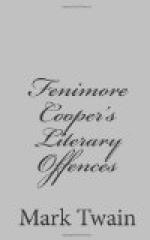We must be a little wary when Brander Matthews tells us that Cooper’s books “reveal an extraordinary fulness of invention.” As a rule, I am quite willing to accept Brander Matthews’s literary judgments and applaud his lucid and graceful phrasing of them; but that particular statement needs to be taken with a few tons of salt. Bless your heart, Cooper hadn’t any more invention than a horse; and I don’t mean a high-class horse, either; I mean a clothes-horse. It would be very difficult to find a really clever “situation” in Cooper’s books, and still more difficult to find one of any kind which he has failed to render absurd by his handling of it. Look at the episodes of “the caves”; and at the celebrated scuffle between Maqua and those others on the table-land a few days later; and at Hurry Harry’s queer water-transit from the castle to the ark; and at Deerslayer’s half-hour with his first corpse; and at the quarrel between Hurry Harry and Deerslayer later; and at—but choose for yourself; you can’t go amiss.
If Cooper had been an observer his inventive faculty would have worked better; not more interestingly, but more rationally, more plausibly. Cooper’s proudest creations in the way of “situations” suffer noticeably from the absence of the observer’s protecting gift. Cooper’s eye was splendidly inaccurate. Cooper seldom saw anything correctly. He saw nearly all things as through a glass eye, darkly. Of course a man who cannot see the commonest little every-day matters accurately is working at a disadvantage when he is constructing a “situation.” In the Deerslayer tale Cooper has a stream which is fifty feet wide where it flows out of a lake; it presently narrows to twenty as it meanders along for no given reason; and yet when a stream acts like that it ought to be required to explain itself. Fourteen pages later the width of the brook’s outlet from the lake has suddenly shrunk thirty feet, and become “the narrowest part of the stream.” This shrinkage is not accounted for. The stream has bends in it, a sure indication that it has alluvial banks and cuts them; yet these bends are only thirty and fifty feet long. If Cooper had been a nice and punctilious observer he would have noticed that the bends were oftener nine hundred feet long than short of it.
Cooper made the exit of that stream fifty feet wide, in the first place, for no particular reason; in the second place, he narrowed it to less than twenty to accommodate some Indians. He bends a “sapling” to the form of an arch over this narrow passage, and conceals six Indians in its foliage. They are “laying” for a settler’s scow or ark which is coming up the stream on its way to the lake; it is being hauled against the stiff current by a rope whose stationary end is anchored in the lake; its rate of progress cannot be more than a mile an hour. Cooper describes the ark, but pretty obscurely. In the matter of dimensions “it was little more than a modern canal-boat.” Let us guess,




